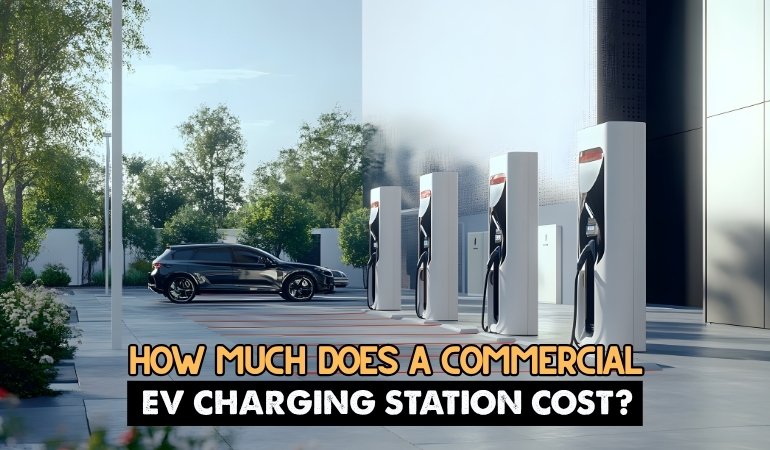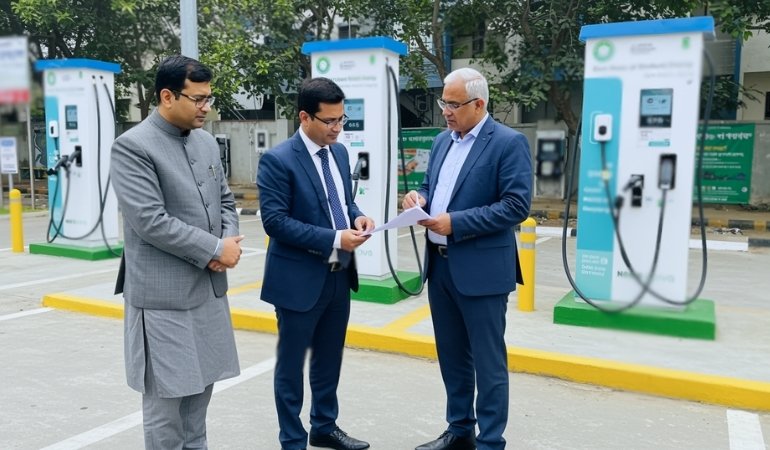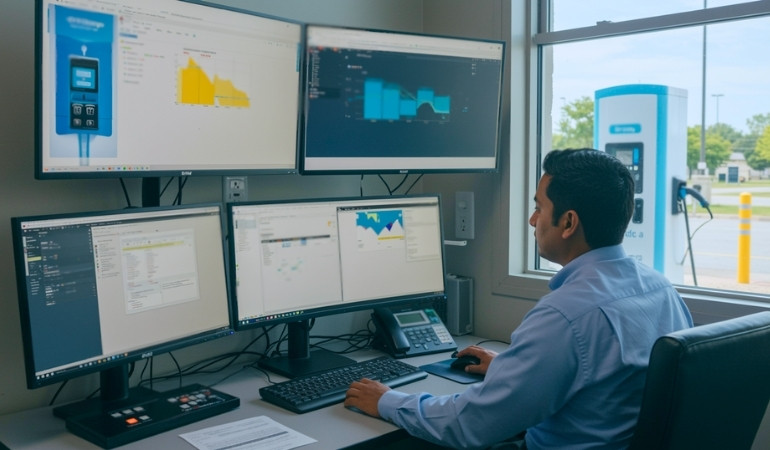Electric vehicle charging stations are showing up in more places every day. They’re helping drivers switch to cleaner energy and keep their cars ready for the road. If you’re planning to set one up for business use, you probably already have one big question in mind—how much does a commercial EV charging station cost?
A commercial EV charging station in Bangladesh costs between BDT 1,000,000 to BDT 5,000,000. The total price depends on the charger type, installation work, power upgrades, and location. DC fast chargers cost more but serve more vehicles in less time.
Do you want to know what really affects these costs and how to plan better? Then keep reading, because this article explains every important detail you need to understand before installing a charging station.
How Much Does a Commercial EV Charging Station Cost?
Installing a commercial EV charger is not as simple as it sounds. It needs planning, money, and the right setup to work well. Many people don’t know how the cost is divided. To understand it clearly, check each section below for full details.

Price Range
Every charging station setup needs a different amount of money to begin. Most commercial stations in Bangladesh cost from 10 Lakh to 50 Lakh Taka. Cheaper options include slower chargers and basic tools for smaller traffic. More powerful stations for heavy use need higher budgets and better parts. A simple setup may cost around 10–15 Lakh, while bigger systems can cross 40 Lakh easily. Picking the right option depends on how much service you want to offer.
Charger Type
Choosing between slow and fast chargers plays a big role in pricing. A Level 2 charger usually costs around 2–5 Lakh Taka per unit. DC fast chargers, which work faster, may cost 10–15 Lakh Taka each. They charge quickly but need more power and strong support systems. These high-speed chargers are great for busy areas with more traffic. They are expensive, but they help serve more vehicles in less time.
Installation Work
Before the station works, you must prepare the site correctly. Installation includes power lines, concrete pads, safety checks, and electric panels. These tasks usually cost about 3–10 Lakh Taka, depending on the place. If extra digging or wiring is needed, the price gets higher. A flat and ready space can help lower this cost. Complex areas with weak power access may increase your budget quickly during this step.
Location Impact
Some places have higher setup costs due to different local needs. In countries like Bangladesh, where charging needs are still growing, businesses usually begin with simple setups. That’s why many start with a basic electric vehicle charging station in Bangladesh to test local use. Depending on local rules and labor rates, costs can rise. These location-based changes usually add about 3–8 Lakh Taka to the total budget. Planning early helps avoid surprise costs.
Power Supply Needs
Power upgrades can be a big reason why prices go up. If your site has strong electricity, upgrades may cost only 2–4 Lakh Taka. But some places need new wires, poles, or a big transformer. These changes can push costs up to 10 Lakh Taka or more. Without the right supply, fast chargers won’t run well. It’s better to check with experts before making your final cost plan.
Ongoing Costs
A charging station still needs money even after it’s fully built. Monthly costs include electricity, repairs, system updates, and simple maintenance. This might range between 10,000–50,000 Taka each month, depending on traffic. Once a year, you may also spend 1–2 Lakh Taka on full checkups. These small but regular costs keep everything running smoothly. Ignoring them can cause damage or system failure over time.
Long-Term Value
Even though the setup is costly, many stations make a steady income later. Some busy chargers earn back 1–2 Lakh Taka monthly from daily users. You can expect to recover the full cost in 2–4 years. Over time, this setup becomes a useful business plan for many people. With more electric cars on the roads, demand will only keep growing every year. A strong setup now means better returns in the future.
Building a station costs money, but it brings steady profit later on. Every part of the setup matters if you want it to last. Think about space, power, and usage before you start planning. A smart start helps avoid big repair costs in the future.
Are There Government Grants or Incentives for Commercial EV Charger Installation?
Getting a commercial EV charger can cost a lot in the beginning, but there are ways to make it easier. Across different places, support is often available to help reduce some of those starting costs. Many people don’t know that governments sometimes help with these costs. Keep reading to learn where and how you might find that support.

Government Programs
Some governments offer programs that help pay for EV charging stations. These programs are made to support clean energy and reduce air pollution. They often cover part of the cost of equipment, installation, or even upgrades. To qualify, you may need to follow certain rules or apply during specific times. Checking local and national websites is a smart first step to see what’s available for your area.
Tax Rebates
Tax rebates are another way to get money back after setting up a charger. Instead of paying full taxes, you get a part of the charger cost returned during tax time. This can lower your final cost a lot. It’s important to keep your receipts and fill out the right forms. Many countries offer this kind of rebate to support electric vehicle charging plans.
Utility Company Support
In many areas, power companies are also stepping in to help. Some offer cash incentives, lower rates, or even free setup guidance. That’s because more EVs on the road can help them plan their energy use better. You can usually find details on your electric company’s website or by giving them a call to ask about EV charging programs.
Local Authority Help
Local city or regional offices may have their own grants or funds. These often depend on your location and the type of business you run. Some areas want more EV chargers nearby, so they offer extra support to those who install them. Visiting your town’s website or calling the office can help you learn what’s offered in your location.
Business Grant Options
Business grants from different programs might also help cover the cost. Some are focused on helping small or green businesses grow. You may need to apply with some paperwork or a plan that explains your charger project. Even though it takes a bit of effort, these grants can really help reduce your upfront cost.
There are many ways to get help when setting up a commercial EV charger. From local offices to national plans, these options can make the process more affordable. Don’t miss out—there’s more to explore when it comes to saving money.
How to Calculate ROI on a Commercial EV Charging Station Investment?
To calculate ROI (Return on Investment) for a commercial EV charging station, you’ll want to compare how much money you’re making from the station to how much you spent to install and operate it. Here’s a simple, step-by-step way to break it down in easy words:
Step 1: Add Up Your Total Costs
Before you make any money, you have to spend money. Let’s look at everything that goes into your total investment:
- Charger cost (like a Level 2 or DC fast charger)
- Installation cost
- Electrical upgrades (if needed)
- Maintenance and repair
- Software or network fees (if you’re using a smart charging system)
Let’s say your total cost is BDT 2,000,000 (20 lakh taka).
Step 2: Estimate Your Yearly Earnings
Now think about the money coming in. How many people will charge their EVs at your station every day?
- Number of daily users
- Charging fee (per kWh or per session)
- Total sessions in a month or year
If you earn BDT 10,000 per day, that’s about BDT 3,650,000 per year.
Step 3: Subtract Yearly Operating Costs
It’s not just about how much you earn; you also have to pay for things like electricity and maintenance. Let’s take those out of your income to get your net profit.
- Electricity bills
- Service or software fees
- Maintenance or repairs
If your yearly operating cost is BDT 650,000, then your net income is BDT 3,000,000.
Step 4: Use the ROI Formula
Now you have your profit and your total cost. Use this simple formula to calculate ROI:
ROI = (Net Profit/Total Investment) × 100
ROI = (3,000,000/2,000,000) × 100 = 150%
Your ROI is 150%, meaning you’ve earned back your money plus 50% profit in one year.
Things That Affect ROI
Your results might vary depending on a few key things. These can make your ROI go up or down:
- Location (more traffic means more users)
- Charger type (fast chargers earn more but cost more)
- Electricity rates
- Pricing strategy (flat rate or per kWh)
- Government grants or incentives (they reduce your upfront costs)
Calculating ROI for a commercial EV charging station helps you see if your investment is truly paying off. With smart planning, the right location, and clear cost tracking, your station can turn into a strong and steady source of income.
Are Fast Commercial EV Chargers Worth the Higher Installation and Equipment Costs?
Some EV chargers can fill a battery in minutes, but they come with a higher price tag. It’s not just about speed—it’s also about long-term value. Let’s break it down and see if fast chargers are really worth the investment.
Setup Costs
Installing a fast charger is usually more expensive than regular ones. You’ll need stronger electric lines, special equipment, and sometimes even upgrades to the local power grid. That’s why the setup cost can go much higher than expected. While evaluating these costs, it’s also important to consider compatibility with the protocol for EV charging stations, especially if you’re aiming for high-speed interoperability across different vehicle brands.
Earning Potential
A fast charger can serve more vehicles in a single day, which means more paying customers. If your location gets a lot of traffic or sits near highways, this can really boost your income. Even if the price per charge is a bit higher, many drivers are willing to pay extra for speed. This helps you earn back your investment faster than with slower chargers.
User Demand
People who use electric vehicles often look for quick and easy charging. If your station offers fast service, it can attract more users who are in a rush or don’t want to wait too long. In busy areas, this can make your station a top choice and help build regular traffic to your site.
Maintenance and Lifespan
High-speed chargers are built with advanced technology, which means they may need more care over time. They might face more wear and tear, especially in places with heavy usage. Regular checks and updates are important to keep everything running smoothly, and this adds to the ongoing cost of operating the station.
ROI Comparison
Even though the upfront cost is higher, the return can be much better if you’re in the right location. Faster chargers can mean quicker profits, especially when people are willing to pay more for time-saving convenience. If you calculate income against the full cost, fast chargers often show better returns over time than slower options.
Fast EV chargers can be a smart choice if you plan carefully and think about future growth. The extra cost can pay off well, especially where drivers need quick charging and reliable service.
What Are the Hidden Costs of Operating a Commercial EV Charging Station?
Setting up a commercial EV charging station sounds simple, but there’s more to it than just plugging in a charger. Small, ongoing costs often get missed during planning. To avoid surprises later, take a closer look below for key details.

Software and Updates
Most EV chargers rely on special software to work properly. This includes things like user management, payment systems, and usage tracking. These tools usually require monthly or yearly fees. Some updates also come with extra charges. If the software is cloud-based, internet costs may be involved as well. That’s why staying on top of these background systems is just as important as the charger itself.
Site Maintenance
Keeping the station clean, safe, and working well doesn’t happen automatically. Regular checks, cleaning, and occasional repairs will be needed. If something breaks, it might not be covered under warranty. Weather-related damage can also lead to extra costs. Trash near the station, broken lights, or even graffiti can affect user trust, so it’s important to plan for upkeep.
Parking Rules
When EV spots are used by non-EV cars, it can cause frustration. You may need signs, ground markings, or even penalties to stop this from happening. In some places, hiring a parking enforcement service is required. That adds to your monthly bills. Also, you might need to reserve space, which could lower your total parking area for other customers.
Communication Costs
For users to check prices, availability, or start charging from their phones, strong Wi-Fi or mobile data systems are needed. Some locations don’t have great signal, so you may need to install signal boosters or private internet lines. These services often come with setup fees and regular charges, which can stack up over time if not planned early.
Construction Work
Many business owners focus on the initial price tag but forget that the cost of EV charging station setup can also include unexpected expenses like trenching, software licensing, and utility upgrades. Even small changes to pavement or wiring can lead to higher bills. Getting permits or following safety rules may add extra steps that slow things down and cost more than expected.
Every charging station comes with some hidden costs that aren’t always clear in the beginning. Understanding these early helps avoid problems later. Make smart choices now by thinking ahead and reviewing all possible expenses.
Frequently Asked Questions
Understanding the cost of setting up a commercial EV charging station can raise many questions. This section provides straightforward answers to the most common concerns, making it easier to get through the planning and budgeting process.
Does the Type of Business Location Affect Cost?
Yes, your business location can change the cost a lot. A place with easy access, parking, and power nearby will cost less to set up. But if your area is crowded or lacks electricity lines, costs will go up. That’s because more work is needed to prepare the space.
Can Solar Power Lower Charging Costs?
Solar power can help reduce long-term electricity costs. You will need to pay extra at the beginning to install solar panels. But after that, you’ll spend less on monthly energy bills. It’s a good idea for areas with lots of sunlight.
Is There a Cost for Maintenance Each Year?
Yes, you will need to pay to keep the charger in good shape. Maintenance includes cleaning, repairs, and checking the charger’s software. These costs may not be high, but they add up every year. It’s important to plan for them early.
Do All Chargers Have Internet or App Support?
Not all chargers come with smart features like app support or Wi-Fi. Some basic chargers work without internet and cost less to install. If you want remote control or payment tracking, you’ll need a smart charger. These usually cost more and need monthly software fees.
Is It Expensive to Paint or Mark EV Parking Spots?
Painting and signs for EV spaces are small but important costs. You may need to paint special lines, add EV symbols, or put up boards. These help people see the charging station clearly and use it properly. The cost is not high, but it’s part of the setup.
Do I Need a License or Permit to Install One?
Yes, in most places, you’ll need some kind of permit. This allows you to build or install electrical equipment safely. Getting a permit may take a few days or weeks and often costs a small fee. Always check local rules before starting your project.
Can I Rent Out the Charger to Other Businesses?
Yes, some businesses rent their charger or offer charging for a fee. This can help earn back the money spent on setup. You’ll need to keep records and set fair prices. It’s a smart way to make extra income from your station.
Will Weather Conditions Increase Setup Costs?
Weather can raise the cost if you need extra safety gear. In rainy or hot areas, the charger may need protection like covers or cooling fans. These items add to the setup cost. Choosing weather-proof equipment is smart if your area has strong climate changes.
Can I Use the Charger for My Own Company Cars?
Yes, you can use the charger for your company vehicles too. This helps save money on fuel and keeps your cars ready to go. Many companies install chargers mainly for their own use. You can still allow public use if you want to earn money.
Bottom Line
Building an EV charging station may sound simple, but many parts affect the cost. From equipment and site work to power and maintenance, each piece adds up. With smart choices, the full setup cost becomes easier to manage. So, if you’re still asking how much does a commercial EV charging station cost, the short answer is anywhere between 10 to 50 Lakh Taka, based on your needs.
To make your investment smarter, start small, check the area, and plan the power early. Always choose trusted experts to avoid mistakes that cost more later. Take time to understand the needs around you before spending big. Best wishes as you begin your EV charging project; may it bring you growth and success ahead.
